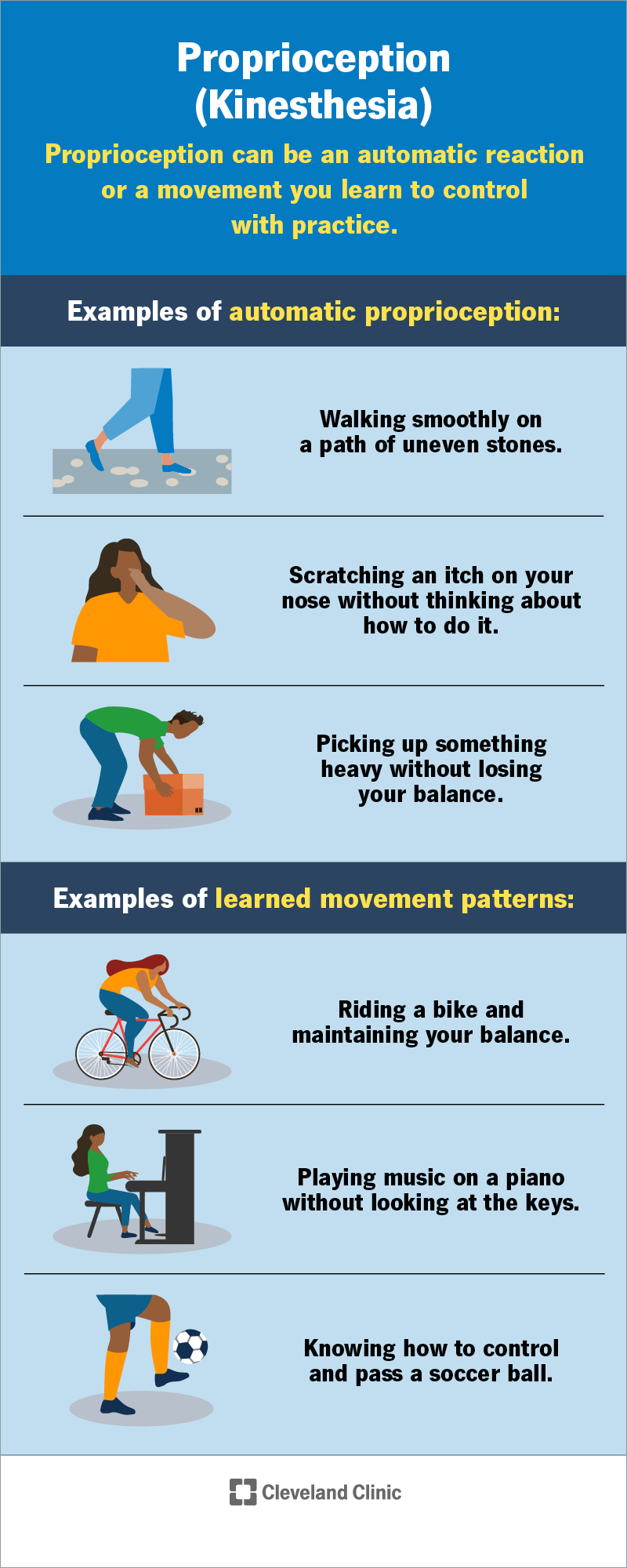Proprioception is one of your senses. It’s your body’s ability to sense its own position and movements in space. Proprioception is a complex automatic process that you can also fine-tune. Many conditions and injuries can affect it.
Advertisement
Cleveland Clinic is a non-profit academic medical center. Advertising on our site helps support our mission. We do not endorse non-Cleveland Clinic products or services. Policy

Proprioception is your body’s ability to sense its own position and movements. It’s an automatic or subconscious process. Proprioception allows your brain to know the position of your body in space without having to rely on visual input alone. It’s also crucial to maintaining balance.
Advertisement
Cleveland Clinic is a non-profit academic medical center. Advertising on our site helps support our mission. We do not endorse non-Cleveland Clinic products or services. Policy
Kinesthesia, or kinesthesis, is the ability to use proprioception and other functions to generate body movement and learn a variety of physical skills. Kinesthesia is a behavioral process that allows your body to detect a movement and learn how to improve on the movement.
Proprioception and kinesthesia make it possible to do a variety of tasks, like tossing something in the trash or eating food with a spoon. It’s also essential for complex skills, like doing a backflip on a balance beam. Without this complex sense, life would look and feel pretty different.
Examples of automatic proprioception and kinesthesia include:
Kinesthesia plays an important role in learned movement patterns, like those necessary to play various sports or do physical hobbies. It takes conscious effort and practice to fine-tune these skills. Some people refer to it as “muscle memory:”
Advertisement
Proprioception is a very complex process — and it happens without you realizing it. Parts of your body involved in proprioception include your:
Signs and symptoms of proprioception dysfunction or poor proprioception may include:
These symptoms and behaviors can affect people at any age. But in general, your risk of proprioception issues increases as you age due to the natural deterioration of your joints, muscles, nerves and brain.
Some examples of injuries, conditions and situations that can affect your sense of proprioception include:
Advertisement
These conditions may cause temporary or long-term (chronic) proprioception issues.
Healthcare providers and sports therapists can use several tests to assess different aspects of proprioception. Some examples include:
Advertisement
Physical therapists and sports therapists may use specialized equipment to assess specific joints for proprioception. The names of these testing techniques include:
Whether you’re an athlete wanting to prevent injuries or fine-tune certain skills or someone with a condition that affects your proprioception, physical therapists may be able to give you specific exercises to improve this sense.
Proprioception involves many body systems and, essentially, all the skeletal muscles and joints in your body. Because of this, physical therapy exercises to improve your proprioception will target specific joints and muscles. They may also strengthen your sense of balance, like one-legged balance or walking in a straight line (like on a balance beam).
Physical therapy may not be able to help some causes of proprioception issues, like permanent brain damage. If proprioception issues affect everyday activities, an occupational therapist can help you find new ways of doing tasks.
When we think of our senses, we often just think of sight, smell, hearing, touch and taste. But proprioception is another key sense that makes life easier and more enjoyable. Without effective proprioception, we wouldn’t be able to effortlessly scratch an itch or ride a bike. Many conditions and injuries can affect this important sense — either temporarily or permanently. Talk to a healthcare provider if you notice a change in your balance or how you’re able to go about physical activities. They can do some simple tests to assess your proprioception.
Advertisement
If you have a neurological condition, you want expert advice. At Cleveland Clinic, we’ll work to create a treatment plan that’s right for you.

Last reviewed on 07/25/2024.
Learn more about the Health Library and our editorial process.